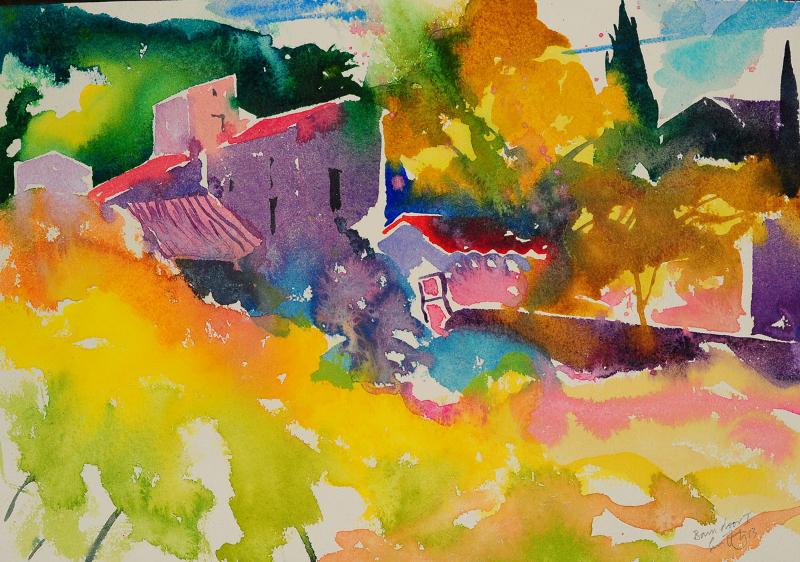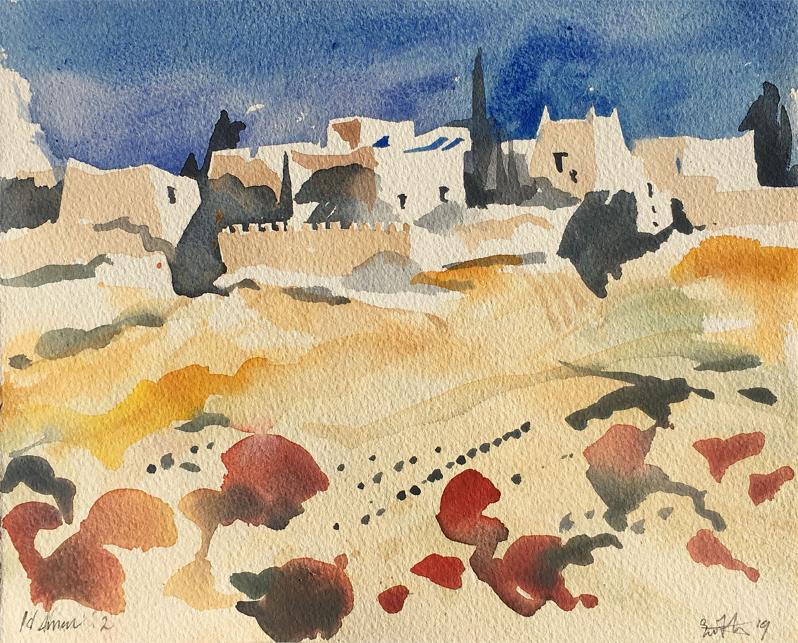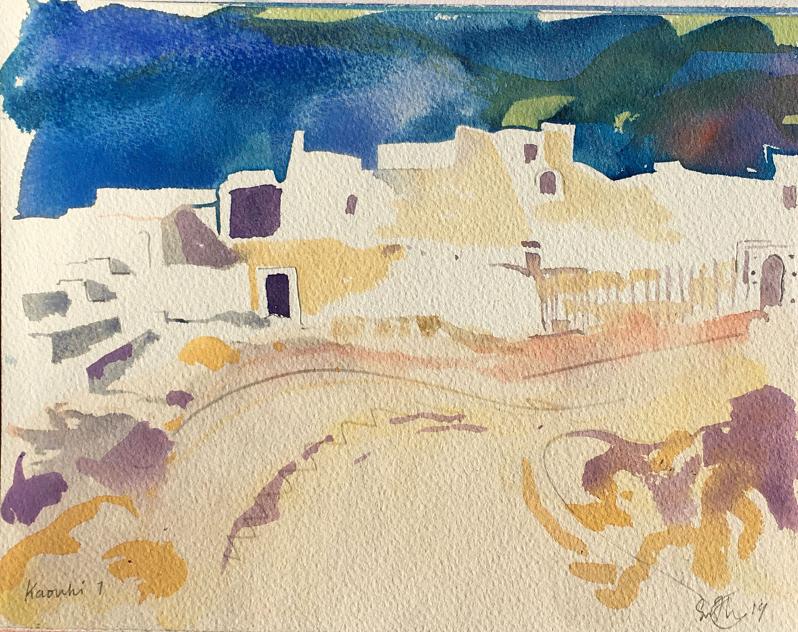


TESTEMONIALS TÉMOIGNAGES
Workshops/ateliers 2018
I loved being on Simon's workshop. Every minute if it. Painting, tuition, eating good food, drinking good wine, visiting your lovely home and Simon's studio.
The accomodation was perfect and all those lovely people! Such interesting conversations!
Thank you once again. I will be back!
Elisabeth from Stockholm
The evenings are filled with animated conversations at romantic candle lit dinners.
Simon can tell you a lot about the wine in the country, he even wrote a book about it with wonderful paintings. The time passes by so quickly during the seminar hours, it is so fascinating to watch Simon teaching his mostly international students in different languages and look at their paintings.
We spent a wonderful time there and we will come back.....
Hilde from Germany
The real thing, a master at work, small groups and animated conversation. At last someone who knows the technique inside out and who has produced a book about it.
Tremendous value.
David, New York
La vraie chose, un maître au travail, des petits groupes et une conversation animée. Enfin quelqu'un qui connaît la technique à fond et qui a produit un livre à ce sujet.
Valeur incroyable.
Paul, Oxford England
Moulieres – what it has come to mean for me
David Shirreff, author of ‘Watercolour, Mired in the Past?’ The Economist
This year, 2019, I realised with amazement it was my fifth time attending Simon Fletcher’s painting course at Moulieres, a farmstead in a wild part of southern France. Like several other amateur or semi-professional watercolourists I spotted, in my case years ago, that Simon had developed his own intense way of representing landscape, in a medium that in the wrong hands can be muddy and wishy-washy. So many people - enough that it cannot be dismissed as hyperbole - have said that Simon Fletcher is one of the best in the world. Does that mean that we have come here in the hope that some of the magic will rub off on us?
None of us wants to be a copycat, but we certainly want to learn better technique and a way of seeing things in front of us, from a real master. That is what we all try to do – with varying success from day to day. Looking back over five years, of course I haven’t achieved what I wanted to, but the results have grown better from year to year, especially in those years when my mind has been uncluttered by other things, allowing me to concentrate fully during the two-week course.
The Moulieres course at its best is a mixture of good company, excellent food provided by Simon’s wife Julie, good humour, and a sense of common purpose as we spend day after day trying to learn, experiment, take risks, encourage each other, sometimes laughing at the result. The students, about eight or half a dozen of them, come from all over Europe, sometimes even farther afield, often with their partners and spouses – who join us at mealtimes for good food, wine and conversation. German and French can be heard nearly as often as English.
Simon is a good teacher, but not one to tell us by numbers how to paint a tree or a flower, or a cloudscape. Ideally he would like us simply to see and work it out for ourselves. But some of the most valuable moments are indeed spent watching him produce a painting before our eyes. It is instructive to see how he mixes colours, how much he loads on his brush, and when he lets colours collide and run together on the paper, or when he lays down a sharp edge of vivid paint. He paints quickly, seldom moving from light to dark as the orthodox manuals recommend. His colours are vivid, often an exaggeration of what the untrained eye might see. But then the Impressionists were doing that 100 years ago. Simon has not re-invented the wheel. But he knows his artists, the good and the bad, and he has learned enough from them to go his own way.
As we watch Simon pause for a moment, mix several colours and then attack a piece of white 300-gramme paper, we are almost sure that this time he’ll get himself into a mess. Surely that bold violet pillar dividing the paper will cause lots of trouble if the colour runs. But no, now that a wodge of yellow has run halfway up the trunk it is clearly the quintessence of a cypress tree. Call them tricks of the trade. But they are the product of a lifetime of experience, and of getting it wrong time and again, as he developed his own intense style.
If that explains why we are here, it is not the only reason. Moulieres is a magical place, created a decade and a half ago by Mike and Jenny Barraclough from a tumbledown hamlet of farm buildings. The transformation included filling in a deep gorge with the rocks dug out of the mountainside, to carve out a tennis court, and to create a gently concave valley of rolling lawn. Mike and Jenny, after illustrious careers in television, medicine and enlivening London’s depressed eastern boroughs, use Moulieres to entertain family, grandchildren and other guests, and to follow their other passions, gardening and painting. They are perfect hosts, part of their charm being that they allow the rest of us to completely take over their house for the first week, and Julie to mastermind accommodation, logistics, and three delicious meals a day. Long may Moulieres continue!
Bruce Houlder’s experience of painting with Simon Fletcher at Moulières
Why did I choose to come to Moulières some 5 years ago, and why do I keep returning? It is of course trite to say my purpose was to learn to paint properly, and in a way that was inspiring not just to me but possibly in the eyes of others. I had tried painting on and off since about 1990, having received 10 short lessons from an architect friend who had once taught at the Chelsea College of Art. I had attended a single day’s course in St Ives and one in Hertfordshire, and 4 days at West Dean College. All of these brief experiences, as I now realise, suffered from some creative defects, and if I achieved one or two paintings in the year that followed that was a success. I painted very little, and learnt probably even less. Something was wrong, because I really did want to paint. Not only was I struggling to distinguish between drawing with colours, and real painting, but I could not draw either. The way I was taught seemed too prescriptive, as if there was only one way to create a desired effect, or to mirror nature in a work. Such judgment is of course too harsh, and such grounding did have value, but did too little to encourage enjoyment, or the freedom that a painter might aspire to. I had felt some early success at copying the works of others, and this taught me a little about some rather bland colour mixing, and how a brush might be used, but nothing about creating art, and far too little about proper perspective. My brother had a watercolour painted by a Victorian ancestor. My greatest success was to copy it, and then replace his painting with my own! After a couple of months, I told him what I had done – he had not noticed a thing. Perhaps this was because he never looked at the painting any more. I do not now want to paint at all if that is to be the result. All this negativity ended when I was encouraged by a friend to come to the Hérault to paint with Simon Fletcher.
Picasso put it best –““Art washes away from the soul the dust of everyday life”, and there was much in my work as a lawyer that needed washing away. Some will take a walk by the sea or in the countryside, others will play an instrument, sing or listen to music, and many of us might do several of these things to feed our souls. I go on long cycle rides in Europe with old friends. And there perhaps we have the answer. Friendship, or as Simon Fletcher pointed out, the laughter of friends who are painting, is often heard when a group is working well. The happiness of a shared pursuit, anecdotes, memories relived among old and new friends from all over Europe, joined by a common creative bond.
The evenings at Moulières are enriched by Julie Fletcher’s exceptional cooking, the good conversation and banter after a days painting perhaps in the gardens that Mike and Jenny Barraclough have created there. The visits to paint in the towns and beautiful locations close to their home, are just the additional touches to the gift that this place bestows under the guidance of Simon Fletcher. I cannot underestimate the value of the memorable times spent here, as my happiness in such sublime pursuit unfolds.
L'acompte payé sur réservation pour certains de nos ateliers sera remboursé uniquement en cas de l'annulation de l'atelier
The deposit paid to reserve some of our workshops will be reimbursed only if the event is cancelled
Simon Fletcher. Art Materials Checklist
The following are some of my preferred materials but if you are used to your own please bring these with you.
Papers - Try some sheets or a block of any of the following
Saunders Waterford 300gm not* (medium) or rough
Fabriano 300gm not* (medium/cold pressed)
Lana 300gm not* or rough
Hahnemuhle 250gm or 300gm not* (Moulin du Coq)
Arches 300gm not* or rough
Various papers for pastel and drawing
*not is short for not pressed
Suggested hand made papers. Ask your art supplier for details
Moulin de Laroque,France
Amatruda, Italy
Brushes petit gris. If you need brushes try three or four various sizes of one of the following makes:
da Vinci
Raphael
Winsor & Newton
Isabey
Drawing materials and pastels
Charcoal,
pencils (HB, 2B, 4B)
Coloured pencils (small box)
Pastel boxes. Bring a small box of one of the following makes of pastel:
Rowney soft pastels
Schmincke artist's pastels
Sennelier artist's pastels
A pastel fixative
Water colours. Tubes or full pans.
reds.
Quinacridone magenta, permanent rose, karmin permanent, alizarin permanent, pyrol red
Cadmium red medium or light
Yellows.
Cadmium yellow deep, cadmium pale & cadmium lemon.
Naples yellow.
Greens.
Phthalocyanine. Chrome oxide
Blues.
Phthalocyanine deep & phthalo cerulean.
Ultramarine.
Cobalt
Earth colours.
Raw umber.
Burnt umber.
Burnt siena.
Yellow or gold ochre
English or venetian red.
Lamp black
Note. Winsor & Newton, Rowney, Sennelier or Schminke are all reliable makes. Whenever possible I use the pigment name for my colours. These are sometimes printed on the tube or pan. Please don't buy a colour that does not have pigment information printed on it
Other things
A comfortable, light stool. A board 40 x 60 cm. A good water spray. Plastic water containers and a small sponge. A sketch book 30 x 20cm. A portfolio 40 x 60cm. A sun hat. An overall or apron.
Almost everything on this list can be bought online, in the UK from Jacksons art, in France and Germany from Boesner or Gerstaeker.
Please don't bring very old materials as they can be disappointing compared to some of the newer products available